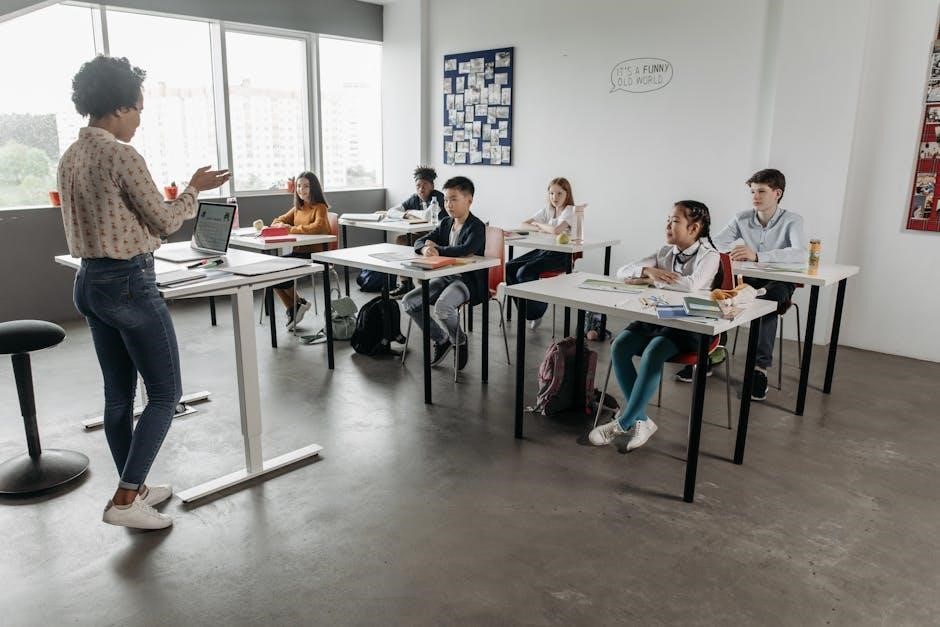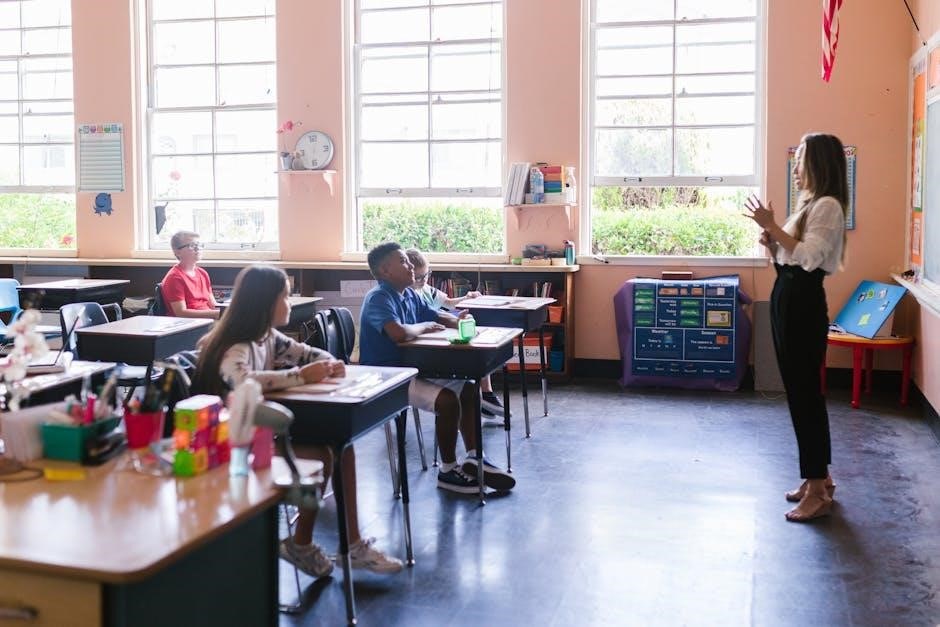
small group instruction pdf
Small group instruction is a powerful, flexible teaching approach that adapts to diverse learning needs, fostering engagement, personalized learning, and meaningful teacher-student interaction, essential for education equity.
What is Small Group Instruction?
Small group instruction is a teaching method where students are divided into smaller groups to receive targeted support and differentiated instruction. It allows teachers to address diverse learning needs, providing personalized attention and feedback. This approach encourages active participation, collaboration, and deeper understanding of concepts. Small group instruction is versatile, applicable across various subjects and educational levels, and is particularly effective for students requiring additional support, such as those with disabilities or English language learners. By focusing on specific skills or content, teachers can cater to individual needs, fostering academic growth and engagement in a structured and interactive learning environment.
History and Evolution of Small Group Teaching
Small group teaching has evolved significantly over time, originating as a method to provide personalized attention in classrooms. Historically, it was used to support students needing extra help, such as Tier 2 and Tier 3 interventions. Over the years, its effectiveness in fostering engagement and academic growth led to its adoption across various educational levels and subjects. The approach gained prominence post-COVID, becoming a cornerstone for addressing learning gaps and ensuring equity in education. Today, small group instruction is a cornerstone of modern pedagogy, offering flexibility and adaptability to meet diverse learner needs, from early literacy to advanced content, and is widely recognized as a key strategy for student success.

Benefits of Small Group Instruction
Small group instruction enhances engagement, personalizes learning, and strengthens teacher-student interaction, leading to improved academic outcomes and better support for diverse student needs and educational equity.
Improved Student Engagement
Small group instruction significantly boosts student engagement by allowing active participation in discussions and hands-on activities. Students feel more comfortable sharing ideas in intimate settings, fostering a sense of belonging. Teachers can address individual questions and misconceptions promptly, ensuring clarity and understanding. This personalized attention motivates students to take ownership of their learning; Additionally, small groups encourage peer collaboration, where students learn from one another and develop teamwork skills. The interactive nature of small group instruction helps combat disengagement, making learning more enjoyable and effective. This approach is particularly beneficial for diverse learners, as it accommodates varied paces and learning styles, creating a dynamic and inclusive classroom environment.
Personalized Learning Opportunities
Small group instruction offers tailored learning experiences, allowing teachers to customize content based on students’ strengths, weaknesses, and progress. This approach enables targeted support, especially for students needing extra assistance or enrichment. By assessing individual needs, teachers can design lessons that address specific gaps, ensuring each student receives relevant instruction. Personalized learning in small groups also fosters independence, as students work at their own pace and explore topics in depth. This adaptability makes learning more effective and meaningful, catering to diverse abilities and promoting academic growth. The ability to adjust instruction dynamically ensures that no student is left behind or unchallenged, maximizing their potential for success.
Enhanced Teacher-Student Interaction
Small group instruction fosters meaningful teacher-student interaction, enabling educators to provide individualized attention and feedback. In a smaller setting, teachers can better understand each student’s learning style, strengths, and challenges, creating a more supportive environment. This proximity allows for dynamic communication, where teachers can clarify doubts, address misconceptions, and encourage critical thinking in real time. Students also benefit from increased opportunities to ask questions and engage in discussions, enhancing their understanding of complex concepts. The personal connection built through these interactions motivates students and strengthens their commitment to learning. This collaborative dynamic ensures that teaching is not only effective but also tailored to meet the unique needs of each learner.
Increased Academic Achievement
Small group instruction is an evidence-based practice that significantly contributes to increased academic achievement. By allowing teachers to target specific skills and address individual learning gaps, students receive tailored support that enhances their understanding and mastery of concepts. Formative assessments within small groups enable educators to monitor progress and adjust instruction, ensuring no student falls behind. This approach is particularly effective for students with disabilities, English language learners, and those needing extra support. Research shows that small group instruction leads to higher academic outcomes, as it allows for focused, data-driven teaching. Regular, targeted interventions in small settings help close achievement gaps, fostering overall academic success and preparing students for future challenges.

Planning Small Group Lessons
Effective small group instruction requires careful planning, including setting clear goals, assessing student needs, and designing engaging activities. Integrating technology and resources enhances learning experiences, ensuring targeted support for all learners.
Setting Clear Learning Objectives
Setting clear learning objectives is crucial for effective small group instruction. It ensures that lessons are focused and aligned with student needs. Teachers should define specific, measurable goals that guide instruction and help students understand expectations. Objectives should be communicated clearly to students at the outset, allowing them to track their progress. Aligning these goals with broader curriculum standards ensures coherence. Additionally, incorporating assessment criteria into objectives helps teachers evaluate student mastery effectively. Clear objectives also enable teachers to differentiate instruction, addressing various learning levels within the group. This targeted approach maximizes learning outcomes and keeps instruction purposeful and efficient.
Assessing Student Needs and Abilities
Assessing student needs and abilities is essential for tailoring small group instruction to individual learning requirements. Teachers use diagnostic tools, formative assessments, and observations to identify skill gaps, strengths, and learning levels. This data helps group students with similar needs, ensuring targeted support. By evaluating prior knowledge and current performance, educators can design lessons that address specific challenges. Ongoing assessment also informs instructional adjustments, ensuring students receive appropriate scaffolding. Tools like mClass, Apex Learning, and Spire provide valuable insights, enabling teachers to track progress and adapt instruction dynamically. This personalized approach ensures that small group instruction is both effective and responsive to student demands.
Designing Engaging Activities
Designing engaging activities for small group instruction involves creating interactive, hands-on tasks that cater to diverse learning styles and abilities. Teachers should incorporate a mix of discussion-based, problem-solving, and collaborative exercises to keep students motivated. Integrating technology, such as digital tools and multimedia resources, can enhance engagement and make learning more dynamic. Activities should align with learning objectives and encourage active participation, critical thinking, and creativity. Providing opportunities for peer collaboration and real-world applications helps students connect concepts to practical scenarios. Additionally, incorporating movement and hands-on materials can cater to kinesthetic learners. Regular feedback and adjustments ensure activities remain relevant and effective, fostering a productive and inclusive learning environment.
Integrating Technology and Resources
Integrating technology and resources into small group instruction enhances learning experiences by providing interactive and dynamic tools. Digital platforms, educational apps, and multimedia resources can engage students and cater to different learning styles. Online collaboration tools, such as shared documents or discussion forums, encourage peer interaction and teamwork. Teachers can also use technology to deliver personalized content, track progress, and provide immediate feedback. Additionally, incorporating video tutorials, virtual field trips, and interactive simulations can make lessons more immersive and relevant. By leveraging these tools, educators can create a blended learning environment that supports academic growth and prepares students for the digital age while ensuring equitable access to resources for all learners.

Strategies for Effective Small Group Teaching
Effective small group teaching involves active learning techniques, encouraging peer collaboration, providing immediate feedback, and using mentor texts to deepen understanding and engagement in focused settings.
Active Learning Techniques
Active learning techniques engage students through hands-on activities, discussions, and problem-solving, fostering deeper understanding and critical thinking. In small groups, teachers can incorporate think-pair-share, role-playing, and collaborative problem-solving to encourage participation. These methods promote real-time interaction, allowing students to apply concepts immediately. Teachers can also use questioning strategies to stimulate reflection and clarify misconceptions. By integrating movement and hands-on tasks, active learning caters to diverse learners, making lessons more dynamic and inclusive. Regular formative assessments during these activities help teachers gauge student progress and adjust instruction accordingly, ensuring targeted support and enhanced learning outcomes in a collaborative environment.
Encouraging Peer Collaboration
Encouraging peer collaboration in small group instruction fosters a supportive learning environment where students engage in shared tasks, promoting teamwork and communication. Teachers can assign roles such as leader, recorder, and presenter to ensure accountability and equal participation. Structured activities like group problem-solving, think-pair-share, and collaborative discussions encourage students to rely on one another’s strengths. Providing open-ended questions and real-world scenarios also stimulates collective thinking. By fostering a positive classroom climate, teachers can help students build trust and respect, leading to more effective collaboration. Peer collaboration not only enhances learning but also develops critical social skills, preparing students for future teamwork in academic and professional settings. Active teacher facilitation ensures productive interactions and addresses any conflicts promptly, maximizing the benefits of collaborative learning.
Providing Immediate Feedback
Providing immediate feedback during small group instruction is crucial for student growth, as it allows for timely corrections and clarifications. Teachers can use formative assessments, observations, and verbal cues to monitor progress and address misconceptions promptly. immediate feedback helps students understand their strengths and areas for improvement, fostering a sense of accomplishment and motivation. By offering specific, constructive comments, educators can guide learners toward achieving learning objectives. Additionally, immediate feedback encourages active participation and engagement, as students feel supported and guided throughout the lesson. This approach not only enhances academic performance but also builds students’ confidence and self-efficacy, making small group instruction more effective and impactful.
Using Mentor Texts and Models
Using mentor texts and models in small group instruction provides students with concrete examples of skills or concepts being taught. These texts and models serve as references, helping students understand expectations and standards. Teachers can select mentor texts that align with learning goals, such as exemplary writing samples or problem-solving strategies. By deconstructing these models together, students gain insights into structures, techniques, and language use. This approach not only enhances comprehension but also encourages students to apply what they learn to their own work. Mentor texts and models are particularly effective in subjects like reading, writing, and STEM, where clear demonstrations of processes are essential for mastery.

Implementing Small Group Instruction
Effective implementation requires organizing the classroom environment, structuring group dynamics, and rotating students between stations to maximize engagement and personalized learning experiences.
Organizing the Classroom Environment
Organizing the classroom environment for small group instruction involves creating dedicated spaces that promote collaboration and focus. Teachers should arrange seating to facilitate face-to-face interactions, ensuring easy access to materials. Designating specific areas for different activities, such as reading or project work, helps minimize distractions. Incorporating flexible furniture and technology integration can enhance learning experiences. Clear visibility and movement paths are essential for monitoring student progress. By structuring the physical space thoughtfully, educators can foster an environment that supports active participation, engagement, and effective small group dynamics, ultimately leading to improved academic outcomes and a more inclusive learning atmosphere.
Managing Group Dynamics
Managing group dynamics in small group instruction requires intentional strategies to ensure productive interactions. Teachers should establish clear expectations for collaboration and respect, fostering a positive atmosphere. Encouraging active participation from all students helps prevent dominance by a few. Strategically grouping students based on strengths and needs can enhance learning outcomes. Rotating students between groups periodically promotes diverse interactions and reduces social cliques. Using mentor texts or structured discussions can guide conversations, keeping students focused. By monitoring dynamics and intervening when necessary, educators can create balanced, inclusive groups where all voices are valued, fostering a collaborative learning environment that supports academic and social growth effectively.
Rotating Students Between Stations
Rotating students between stations in small group instruction allows for varied learning experiences and targeted support. Teachers can organize stations to address different skills or topics, ensuring students engage with diverse activities. Grouping students by similar learning goals ensures tailored instruction. Clear transitions and timed rotations maintain structure, minimizing disruptions. This approach encourages active participation and exposure to multiple learning strategies. Incorporating technology or hands-on resources at each station enriches engagement. Regularly assessing student progress during rotations helps refine instruction. By strategically rotating students, educators can address individual needs, promote collaboration, and maximize learning opportunities, creating a dynamic and effective instructional environment that supports all learners.

Assessment and Feedback in Small Groups
Assessment and feedback are crucial in small group instruction. Teachers use formative techniques to monitor progress, adjusting instruction to meet needs. Immediate feedback enhances learning outcomes.
Formative Assessment Techniques
Formative assessments are integral to small group instruction, enabling teachers to monitor student progress and adjust teaching strategies. Techniques include exit tickets, quizzes, and verbal checks, providing immediate insights into understanding. These assessments help identify misconceptions and skill gaps, allowing for targeted interventions. By using formative data, educators can differentiate instruction, ensuring each student receives appropriate support. Regular feedback loops foster a growth mindset, encouraging students to reflect on their learning. This ongoing process ensures instruction remains responsive and effective, ultimately enhancing academic outcomes in small group settings.
Using Data to Inform Instruction
Using data to inform instruction is crucial in small group settings, allowing teachers to make informed decisions that cater to individual student needs. By analyzing assessment results, progress monitoring, and observational data, educators can identify learning gaps and strengths. This data-driven approach enables targeted interventions, ensuring that instruction is tailored to specific requirements. Teachers can adjust lesson plans, incorporate additional resources, or modify teaching strategies based on the insights gained. Regular data review fosters a responsive and adaptive learning environment, promoting personalized growth and improved academic outcomes for all students in small group instruction.

Differentiated Instruction in Small Groups
Differentiated instruction in small groups allows teachers to tailor learning experiences to individual needs, ensuring diverse learners receive targeted support and challenges through tiered approaches and personalized activities.
Tiered Instructional Approaches
Tiered instructional approaches within small group instruction involve dividing students into groups based on their learning needs, with Tier 1 for all, Tier 2 for targeted support, and Tier 3 for intensive interventions. This method ensures interventions are tailored to specific needs, enhancing academic outcomes. Teachers use assessments to form groups, delivering focused lessons that address skill gaps. This approach supports educational equity by providing scaffolding for diverse learners. It also promotes engagement and progress monitoring, ensuring no student is left behind. Tiered instruction aligns with research-backed practices, making it a cornerstone of effective small group teaching strategies.
Creating Learning Centers
Creating learning centers is a versatile strategy within small group instruction, allowing students to engage in self-directed or collaborative activities tailored to their learning needs. These centers are organized as activity-based stations, fostering active participation and hands-on learning. Teachers can design centers to focus on specific skills, such as reading, writing, or problem-solving, incorporating digital tools and hands-on materials. Learning centers promote differentiation by catering to varied learning styles and pace. They also encourage peer collaboration and independent practice, enabling students to take ownership of their learning. By integrating choice and autonomy, learning centers enhance engagement and motivation, making them a valuable component of small group instructional strategies.

Technology Integration in Small Group Instruction
Technology enhances small group instruction by providing digital tools, online collaboration platforms, and interactive resources, creating dynamic learning environments tailored to diverse student needs and preferences.
Digital Tools for Enhanced Learning
Digital tools revolutionize small group instruction by providing interactive and engaging resources. Educational apps, online platforms, and digital whiteboards facilitate real-time collaboration and feedback. Tools like Kahoot! and Quizlet enable gamified learning, while platforms such as Google Classroom and Padlet support shared workspaces. Digital simulations and virtual labs offer hands-on experiences, making complex concepts accessible. These tools also allow teachers to track progress and provide personalized support. By integrating technology, small group instruction becomes more dynamic, fostering deeper understanding and student engagement. Digital tools not only enhance learning but also prepare students for the demands of a technology-driven world, making them essential in modern education. They bridge gaps and cater to diverse learning styles, ensuring inclusive and effective instruction.
Online Collaboration Platforms
Online collaboration platforms are essential for fostering teamwork and communication in small group instruction. Tools like Google Classroom, Padlet, and Trello enable students to share resources, complete tasks, and interact in real-time. These platforms allow teachers to assign group projects, track progress, and provide feedback effortlessly. Interactive features such as discussion boards and virtual whiteboards enhance engagement and idea sharing. Additionally, platforms like Microsoft Teams facilitate live collaboration, making it easier for students to work together remotely. By leveraging these tools, educators can create dynamic learning environments that promote active participation and meaningful collaboration, ultimately enriching the small group instruction experience for all students.

Challenges and Solutions
Small group instruction faces challenges like managing diverse learner needs and classroom disruptions. Solutions include differentiated strategies, structured routines, and targeted support to ensure effective learning outcomes.
Managing Diverse Learner Needs
Managing diverse learner needs in small group instruction requires strategic planning and differentiation. Teachers can use assessment data to identify individual strengths and challenges, grouping students with similar goals. Differentiated instruction allows tailored support, while scaffolded materials and mentor texts provide additional structure. For English language learners and students with disabilities, visual aids and simplified language can enhance understanding. Offering choices within activities caters to varying learning styles, while flexible grouping ensures students receive targeted interventions; Regular progress monitoring and feedback help address gaps, ensuring all learners benefit from small group instruction. This approach fosters inclusivity and equity, meeting the unique needs of each student effectively;
Addressing Classroom Management Issues
Classroom management is crucial for effective small group instruction. Establishing clear expectations and routines helps minimize disruptions. Teachers can use non-verbal cues, such as hand signals, to maintain focus. Active monitoring during group work ensures students stay on task. For off-task behavior, providing choices within activities can re-engage learners. Smooth transitions between groups are achieved with timers and visual reminders. Positive reinforcement, like specific praise, encourages responsible behavior. Pre-teaching social skills, such as active listening and respectful communication, reduces conflicts. These strategies create a structured yet flexible environment, allowing teachers to address diverse needs while maintaining order and maximizing learning opportunities for all students in small group settings.

Future Trends in Small Group Instruction
Future trends include blended learning approaches, integrating technology for personalized pathways, and leveraging data to tailor instruction, ensuring small group teaching evolves to meet modern educational demands effectively.
Blended Learning Approaches
Blended learning integrates traditional teaching methods with digital tools, creating dynamic, personalized learning experiences. This approach allows students to engage in small group activities both in-person and online, fostering collaboration and flexibility. By leveraging technology, educators can design tailored lessons that cater to individual needs, enhancing engagement and academic outcomes. Blended learning also supports data-driven instruction, enabling teachers to track progress and adjust strategies. This model encourages active participation, prepares students for future challenges, and bridges the gap between classroom and digital learning environments, making it a cornerstone of modern educational innovation. It is particularly effective in diverse classrooms, promoting equity and accessibility for all learners. Teachers can rotate students between stations, combining teacher-directed and independent activities, ensuring a balanced and inclusive learning experience. This approach aligns with differentiated instruction, offering tiered support and learning centers to meet varied student needs, thus optimizing the effectiveness of small group instruction in a blended setting.
Personalized Learning Pathways
Personalized learning pathways tailor instruction to individual student needs, enabling tailored academic growth. By leveraging assessment data and learning analytics, educators create customized learning plans that address unique strengths and challenges. Small group instruction plays a vital role, as it allows teachers to deliver targeted support and scaffold learning experiences. Technology enhances this approach by providing adaptive resources and real-time feedback, ensuring students progress at their own pace. Personalized pathways foster student autonomy, encouraging learners to take ownership of their education. This approach aligns with differentiated instruction, offering tiered support and flexible grouping strategies. By integrating personalized learning pathways, small group instruction becomes more impactful, equipping students with the skills needed for long-term success in diverse educational settings.
Small group instruction is a versatile and effective strategy, fostering personalized learning, engagement, and academic growth, while ensuring equity and targeted support for diverse learners in various educational settings.
Summarizing Key Points
Small group instruction is a highly effective teaching method that addresses diverse learning needs, fostering engagement and personalized learning. It adapts across subjects and age groups, promoting active participation and immediate feedback. By setting clear objectives and designing engaging activities, educators can tailor instruction to meet individual needs. Integrating technology and resources enhances learning experiences, while ongoing assessment ensures progress tracking. Small group instruction supports educational equity by providing targeted support, particularly for students needing Tier 2 and 3 interventions. Its flexibility allows teachers to address unfinished learning and scaffold skills effectively. Ultimately, this approach strengthens academic achievement, builds confidence, and ensures all students receive the attention they need to thrive.
Final Thoughts on Effective Implementation
Effective small group instruction requires intentional planning, flexibility, and a focus on student-centered strategies. Teachers must be prepared to adapt instruction based on real-time student needs and feedback. By leveraging diverse teaching methods, integrating technology, and fostering collaboration, educators can create dynamic learning environments. Ongoing professional development and reflection are essential to refine practices and address challenges. The benefits of small group instruction, such as improved engagement and personalized learning, underscore its value in modern education. When implemented thoughtfully, small group instruction has the potential to transform teaching and learning, ensuring all students achieve meaningful academic growth and success.